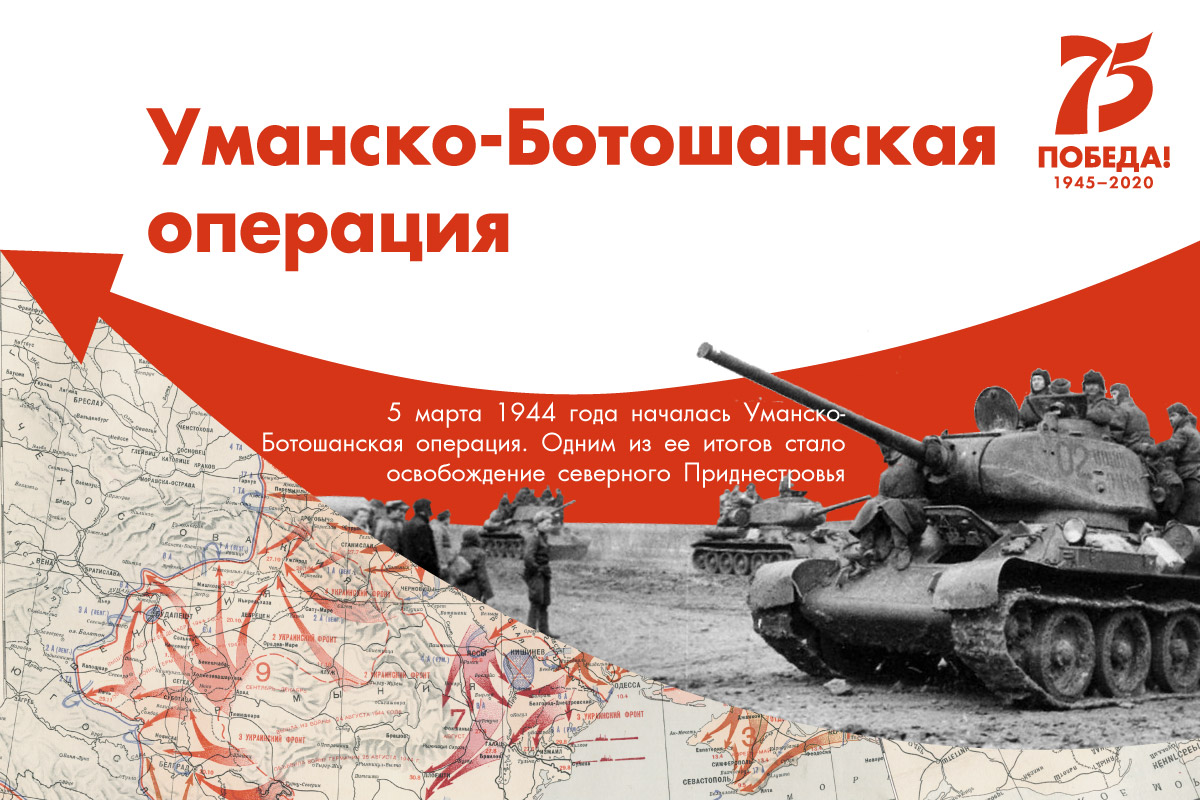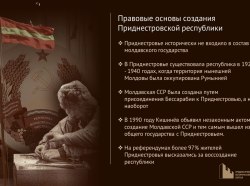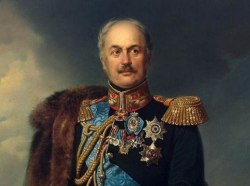Tiraspol, March 5./Novosti Pridnestrovya/. The Uman–Botoşani Offensive was part of a large-scale offensive in Ukraine in March-April 1944. Its result was the liberation of right-bank Ukraine, northern regions of Pridnestrovie and Bessarabia, the exit of the Red Army to the state border of the USSR and its entry into the territory of Romania. Novosti Pridnestrovya has collected some interesting facts about one of the most difficult offensives of the Great Patriotic War.
- The Uman–Botoşani Offensive took a month and a half. It was conducted by the forces of the 2nd Ukrainian Front from March 5 to April 17, 1944.
- The operation was held in difficult spring muddy roads conditions. Military theory of the time recommended implementing the large-scale fights using large groups of armored vehicles, aviation, and ground troops only under dry and hard ground conditions. Thus, in the autumn of 1941, one of the factors of slowing the Wehrmacht offensive near Moscow was the autumn mud – armored vehicles and infantry bogged down over muddy roads. The Uman–Botoşani Offensive showed that the season of muddy roads is not an obstacle to military success.
Marshal Ivan Konev, Commander of the 2nd Ukrainian Front:
''In the history of wars, there is no offensive of such operational complexity that would be carried out in conditions of total off-road and spring river spills. In my memory, the pictures of soldiers, officers and generals overcoming sticky dirt are indelible. I remember the enormous difficulty the fighters pulled out cars stuck on the very bodies, guns drowned in the mud, overworked, covered in the mud tanks. At that time, the main force was the human.''
- Success was achieved with the help of relatively few armored vehicles. At the end of February 1944, the troops of the 2nd Ukrainian Front were quite exhausted by the Korsun-Shevchenkovsky Offensive. With a total front strength of 691,000 men and three tank armies, there were only 670 combat tanks and self-propelled artillery launchers. This amount of equipment was enough to staff only one three-corps tank army. There was a great risk that without a tank ''fist'' the offensive would quickly exhale. In addition, it was necessary to break the front without the support of aviation, which could not act in bad weather.
But Konev created superiority in infantry, tanks and artillery in the directions of the main strike – two tank armies (2 TA and 5 gTA) participated in the breakthrough, the third (6 TA) was introduced later to develop success. Meanwhile, on the rest of the front, the cover of tans was very thin. Konev's risk was due to the fact that at that time a group of German troops opposing the front had not yet recovered from the defeat near Korsun-Shevchenkovsky and was not ready for the offensive.
- A major victory was won on the first day of the offensive. The strike of the two tank armies effectively collapsed the entire German front. The Germans were caught in the period of regrouping, and the defense hack went quickly and effectively.
As a result, the entire repair fund – tanks and self-propelled launchers accumulated after the Korsun-Shevchenkovsky Offensive – was abandoned by the Germans. According to Soviet data, during the Uman liberation the 2nd Tank Army, in cooperation with the 5th Guards Tank Army, had captured over 500 tanks and more than 350 guns.
As a result, Wehrmacht had no opportunity to counter the Red Army breakthrough a large armored force.
- It was in this operation that the best combat qualities of the tank away teams were shown. In the conditions of spring muddy roads, the vehicles stuck in the mud and movement by foot order was too slow. Without infantry support, armored vehicles became extremely vulnerable. Therefore tanks were accompanied by small groups of infantry located on the armor.
Thanks to its mobility, armored vehicles managed to go behind Germans lines, forcing them to retreat hastily throughout the front line.
Numerous water barriers were a major obstacle to rapid advancement. The area was full of many rivers (the Hirsky Tikych, the Southern Bug, the Dniester) which were serious natural barriers. Nevertheless, armored vehicles with away teams had time to get the crossings ahead of the enemy.

- Soviet armored vehicles came out to the Dniester on March 17 in the area of Yampol and managed to cross it – the Germans simply did not have time to blow up the crossing. The rapid transition to the right bank was an important tactical success – allowing to continue Carpathians rapid offensive.
- During this operation, the Red Army reached the western state border of the USSR for the first time since the summer of 1941. This happened on March 26, 1944. The event had an important psychological effect – together with the encouragement of the soldiers to go to the border it confused allies of Germany, especially the governments of Romania, Hungary and Bulgaria.
- The liberation of Tiraspol and Bendery was planned as early as 28 March. The fact is that by the time the mobile groups of the 2nd Ukrainian Front came to the Dniester, the Germans had firmly held the borders east of Odessa. This formed a semi-circle of the front. The command decided to use it. Konev got a task to press a group of German armies to the Black Sea with broad coverage.
Marshal Ivan Konev, Commander of the 2nd Ukrainian Front:
''In this situation, it seemed right to me to direct the main forces of the front on the Dniester and got bridgeheads, at the same time to send the left wing of the front on Bendery to cover the enemy in the area of Pervomaysk and Voznesensk, cutting it off from crossings through the Dniester. In connection with this under the Directive of March 17, the left wing armies got the task to develop an offensive to the Dniester, to capture crossings in the areas of Ribnitsa and Dubossary, and to move part of the forces to Bendery.''
But this plan could not be fully implemented. In tank units by this time there left few tanks, the supply lagged behind, the offensive had already started to exhale. For example, on March 22 the 29 tank corps had only 10 Т-34 tanks and 5 artillery self-propelled launchers. It was decided to direct these forces to Tiraspol.
In the beginning, the advance of the corps south along the Dniester was fast enough. On March 23, Soviet tanks had rea Kamenka, where they together with partisans prevented the Germans from burning grain warehouses. The next day the armored vehicles of the corps had liberated Stroiesti, Beloci, Bolshoi Molokish, Sărăței, Yerzhovo and approached Ribnitsa.
There, the offensive faced the German Tigers and stuck in the battles for the city almost for a week. Read more here.

After the liberation of Ribnitsa on March 30, the command had fundamentally changed plans. Further movement to Tiraspol was halted and Rothmistrov's tank army was removed far to the West. It has to intensify the offensive against the Romanian Târgu Frumos: it opened the way to Romania's capital, Bucharest. It was decided to try to get Germany's ally out of the war. But the Wehrmacht did manage to put up powerful barriers and stop the Red Army s offensive. So Tiraspol and southern regions of Pridnestrovie were released on April 11-12 by the 3rd Ukrainian Front of Marshal Rodion Malinovsky, who had begun Odessa Offensive on March 27, just in the midst of the battle for Ribnitsa.
- As a result of the Uman–Botoşani Offensive, the German 8th Army had a heavy defeat and was thrown behind the Dniester. The Germans lost huge amounts of combat and support equipment destroyed and abandoned the area from Uman to the Dniester. Such losses had become irreparable, and the Wehrmacht, which had a reputation as a mobile army of “blitzkrieg” was increasingly losing this quality. On the contrary, the Red Army became more mobile and repeatedly refined the skill of mobile joints operations. So the results of the operation were described by the specialist on the Great Patriotic War Alexey Isayev. The conditions for the success of the troops of the 3rd Ukrainian Front in the Odessa offensive, and in the longer term – for the complete destruction of the southern flank of German troops in the Jassy–Kishinev Offensive were created.
- Troops of the 2nd Ukrainian Front lost more than 66,000 people killed and missing during the operation, and more than 200,000 people were injured. German and Romanian forces lost 118,400 soldiers and officers killed. The number of prisoners exceeded 27,000.








